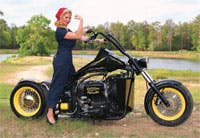Most propulsion drives we describe either deal with off-highway equipment or hybrid hydraulic drives. Let’s face it, conventional hydrostatic transmissions (HSTs) for over-theroad vehicles are rare. But Ron Holcomb, of Hydradyne Hydraulics LLC, didn’t let that discourage him when he decided to build a motorcycle powered by a diesel engine and driven by hydraulics.
Holcomb calls it the Hydra-Ride, and it’s powered by a Kohler KDW 1404 diesel engine. The 4-cylinder, 1372-cc package delivers 34.9 hp at 3600 rpm and 62 lb-ft of torque at 2000 rpm. The HST uses a Bondioli & Pavesi MPV variable-displacement axialpiston pump that supplies a GM05 radial-piston motor from SAI Hydraulics.
Holcomb explains, “I chose the SAI motor because of its high starting torque and high speed ratings. I needed a motor with high starting torque for decent acceleration, rated to 5000 intermittent psi, and capable of output speeds of 800 rpm and higher. There aren’t many motors that can meet all of these requirements. Also, SAI offers a speed pickup, which I use for my speedometer and odometer.”
| Additional specs about the machine |
|
Hydra-Ride is born
So what prompted Holcomb to take on the task of making a hydraulically powered street bike? He explains, “Early in my career at Hydradyne, I was at our trade show booth and suggested to management that we feature a bike to draw attention to our booth. They thought it was a great idea and management offered to donate any hydraulic components, electronics, and plumbing I would need.
“I started estimating the cost, then I found a licensed builder for the frame so I could get a VIN for a title and tags. The bike is titled in my name, and sometimes I keep it at home and sometimes at Hydradyne’s shop. So I am the designer and owner. Kent Weeks, of Lucky Devil Metal Works was the builder. He also did most of the paint.”
Sophisticated control
Holcomb uses the hydrostatic drive as a continuously variable transmission. “I thought a lot about different control schemes. I could have read engine speed for control and followed the torque curve of the engine. But I wanted to use a foot switch or thumb wheel to set pump flow. When I discovered that PM Contour offers 6-button [handlebar] grips, I decided to use that to control the pump.” The six buttons control the left turn signal, decrease pump displacement 10%, increase pump displacement 10%, activate an air-cylinder- activated center stand, sound an air horn, and the right turn signal.
“A small 12-Vdc compressor supplied with the bike’s air shocks provides air for the shocks and the center stand cylinder. A check valve isolates the air shocks from the center stand. We welded a section of pipe to the frame to serve as a receiver for the compressed air. The center stand cylinder is actuated by a 2-position 4-way Parker pneumatic valve. I programmed an interlock into the pump’s electronic control. The stand will not go down when a command signal is routed to the pump, and the HST will not engage unless the stand is commanded up. I command the stand up, then I pressurize the air shocks. As soon as the bike lifts a couple inches, the stand retracts.
“I control the pump with Parker Hannifin’s IQAN MD3 display module (http://bit.ly/hp1211iqan). Right now I have ten pump displacements programmed. I am playing with the settings and may eliminate a couple. That’s the beauty of the IQAN — I can hook up my laptop, make changes, and go.
“I programmed in ramping function for smooth shifting, and I get great hydrostatic braking from the pump. I also installed IQAN pressure transducers for system and charge pressure, and an IQAN temperature transducer provides oil temperature.”
However, an issue with the HST is that without the engine running, the back wheel will not rotate. Holcomb resolved this by installing a 2-position, 2-way, normally closed valve to open a flow path between the motor’s inlet and outlet ports. “Squeezing a standard hydraulic clutch control shifts the valve, which allows me to push the bike around when the engine is off.”
Holcomb reveals that the “gas” tank holds about 4 gal of hydraulic oil and 2 gal of diesel fuel. “Because I straddle the reservoir, which is at the rear of tank, I need to keep the oil as cool as possible. Keep in mind I am in Houston, where ambient temperatures can exceed 100° F.” To cool the oil, Holcomb specified a Series MA heat exchanger from Thermal Transfer Products. This is a bar-and-plate brazed aluminumcore heat exchanger that was selected for its compact size, light weight, and high heat transfer for its size.
Holcomb concludes, “I haven’t done an official test, but I estimate I’m getting about 45 mpg. I can cruise about 55mph, at 2000 psi, and about 2300 engine rpm. It’s interesting to watch the system pressure as I change engine speed and pump displacement.” That does sound interesting, but most of us would probably just like to see this bad machine in action.
For more information on the Hydra-Ride, contact Ron Holcomb at [email protected].
See a short slideshow of the bike below, with alternative views and close-up images of the hydraulic system.
Click below to see a video of the chopper cruising the streets of suburban Houston:
Click below to see a video showing driver’s-eye view using helmet cam at speeds approaching 60 mph:


